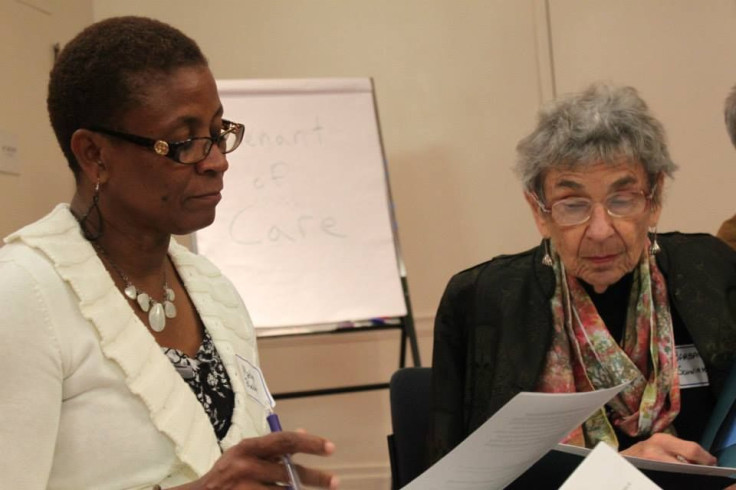Introducing MyRA: A New Solution To America's Retirement Crisis

“That took a lot out of me,” Marilyn Blackett’s patient says, stirring from an afternoon nap. She pauses before she adds, “I know it took a lot out of you too, Marilyn.”
Blackett nods in agreement. It had taken a lot out of her. “We're lucky to have each other,” she says.
Every work day is physically demanding, but days like this, when they visit the doctor, are particularly draining for both women. Still, Blackett, 53, loves her job as a home health aide.
Two months after 9/11, Blackett moved to New York City from Trinidad and Tobago. Now, she spends four days a week caring for an elderly woman in Queens, New York, who has Parkinson's disease.
When she’s with her patient, as she calls her, Blackett works around the clock dispensing medication, cooking meals, cleaning bathrooms, doing laundry and anything else that is needed. Medicaid pays for the service, but reimburses her for only 12 hours a day. At the end of the week, Blackett earns $520.
Although she’d like to retire eventually, she has yet to start setting money aside. Saving for retirement is hard for most people. When you make about $10 an hour, it’s nearly impossible.
The Obama administration wants to change that. In his 2014 State of the Union address, President Barack Obama announced his plans to work with the U.S. Treasury Department to create an easier way for Americans to save for retirement through an account called myRA.
“Politically, that was the only way the administration could do it -- through an executive action. It was not a legislative action,” says Christian Weller, Ph.D., a professor of public policy and public affairs at the University of Massachusetts, and the author of "Retirement on the Rocks."

After an initial pilot program, myRA is now available to all Americans. “MyRA removes many of the common barriers to saving, like fees or minimum requirements, and gives people an easy way to get started,” U.S. Treasury Secretary Jacob J. Lew says.
In fact, the most common barrier to saving for retirement is not having enough money. Those that have, save. Households that have managed to put away money for retirement earn more than 2.4 times the annual income of households that do not have a retirement account, according to a recent report from the National Institute on Retirement Security.
Some financial advisers have criticized the myRA initiative, saying it does not go far enough. “I think if they really were trying to help people they would focus on financial literacy more than anything else,” says Mina Black, founder of In The Black Financial Wellness, which provides financial workshops to corporate employees. “A lot of people don’t know what they don’t know. They need the basics first.”
MyRA functions like a Roth IRA, with a contribution limit of $5,500 for 2015 and 2016. The account charges no fees and does not require a minimum deposit. MyRA funds earn interest at the same rate as investments in the Government Securities Fund, which earned 2.31 percent in 2014 and an average annual return of 3.19 percent over the 10-year period ending December 2014.
“Three percent is not going to get you anywhere near where you need to be for retirement. You can open up a Roth IRA at Fidelity without any fees. Plus, at these other firms you have access to more investment options,” Black says.
To fund a comfortable retirement, experts recommend saving 8 to 11 times your annual salary. Yet, 62 percent of 55- to 64-year-olds have less than one year’s salary set aside. The median retirement account balance for near-retirement households is a mere $14,500. Across all working-age households, the median balance is $2,500.
Even that amount would be progress for Blackett, who is part of the 45 percent of Americans -- or 40 million households -- who have nothing saved for retirement.
The Treasury Department views myRA as a way to begin addressing America’s retirement crisis. "MyRA alone will not solve the nation's retirement savings gap, but it will be an important stepping stone for encouraging and creating a nation of savers,” Lew says.
Creating a nation of savers is a tall order when 51 percent of Americans are scraping by on less than $30,000 a year. “I am unable to save anything. My rent went up $50, and I had to cut my internet in order to pay that extra $50 into my rent. It’s a little bit more than half my paycheck,” Blackett says.
Many working-age Americans consider retirement a distant goal. Among those who earn less than $40,000 per year, 55 percent plan to keep working as long as possible or never plan to retire, according to a recent survey from the Federal Reserve Board.
As for Blackett, she says she intends to retire between ages 60 and 65. That is unlikely unless she moves in with one of her daughters, something she isn’t ready to do, despite an open invitation from both of them. “I like to be independent,” she says.
“For people above the poverty line, the evidence suggests that even low-income people can save money. They don’t save huge amounts, obviously, but they can save money,” Weller says.
Dean Karlan, a professor of economics at Yale University and co-founder of goal-setting website Stickk, says saving money has to be prioritized at the beginning of the month, when there is still money in the bank account. “The best way of saving for retirement is to get it out of your mind. The luxury of having electronic withdrawals from a paycheck is that we don’t have to think about it. It just happens,” he says.
MyRA allows for automatic contributions, as well as penalty-free withdrawals, which makes it more flexible than other retirement savings accounts. It’s not designed to be a long-term solution, however. Once the balance reaches $15,000, it must be rolled over to a private-sector Roth IRA.
Black, who also teaches financial literacy workshops as a volunteer with the Coalition for Debtor Education, worries that myRA will give people a false sense of security. “Ten to 20 years from now, when those people are ready to retire, they’re going to have a lot of people that are upset,” she says. “They’re going to be like, 'Wait a minute, I thought you said this would allow me to retire comfortably.' ”
Currently, 63 percent of retirees rely on Social Security as a major source of retirement income, according to the 2015 Retirement Confidence Survey. The average benefit amount as of June was $1,335 a month, or $16,020 a year. To qualify for that amount, a person needed to earn an average wage of $46,481.52 in 2014, and to have waited until full retirement age to claim benefits.

According to Weller, truly addressing the retirement crisis will require substantial changes to public policy.
“Raising incomes at the bottom -- and that means higher minimum wage, paid family leave, better benefits -- would make it easier for people to save for retirement in two ways: It gives them more money, obviously, but it also gives them economic security and reduces stress. You’re no longer living day to day, you’re now focusing on the future,” he says.
That resonates with Blackett, who spends her free time volunteering as one of the worker leaders for the National Domestic Workers Alliance, advocating for basic labor protections like minimum wage, overtime and paid time off.
“When you don’t have to stress about living paycheck to paycheck, and you could see something that you could put aside, your mind gets more comfortable,” she says.
Blackett says she hopes there will be changes in the system. But until then, she says, “I have to live.” On days when she doesn’t catch a ride to work, she leaves her basement apartment in Brooklyn just before 5 a.m. She takes four subway rides and a bus trip before walking the three blocks to her patient’s home.
She may not be able to save for her own future, but she does caution her daughters about making the most of their careers, which is advice they have taken to heart. Both of her daughters work for the government, and can expect to retire with a pension one day.
“I always tell them, 'Hear this: You have to do better than your mother. You have to get up and do stuff,'” she says.
© Copyright IBTimes 2024. All rights reserved.




















